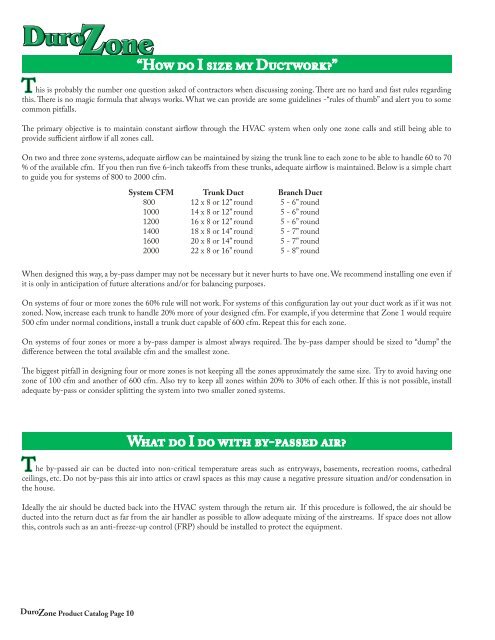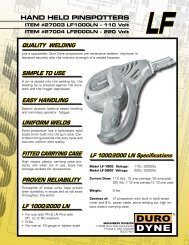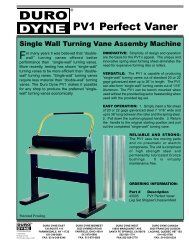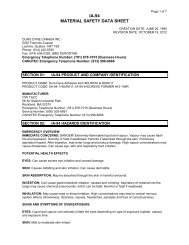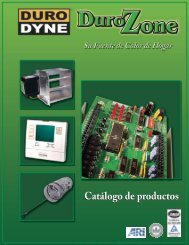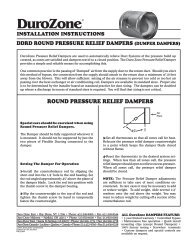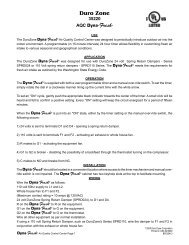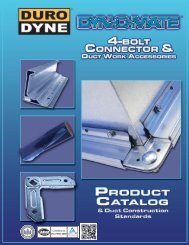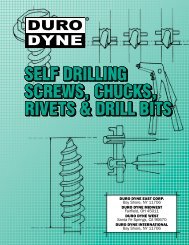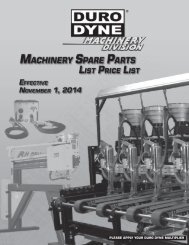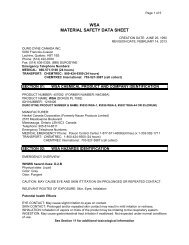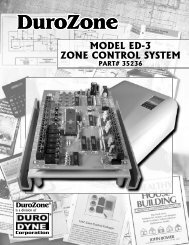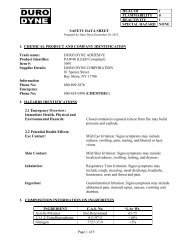DuroZone Product Catalog - Duro Dyne
DuroZone Product Catalog - Duro Dyne
DuroZone Product Catalog - Duro Dyne
Create successful ePaper yourself
Turn your PDF publications into a flip-book with our unique Google optimized e-Paper software.
“How do I size my Ductwork?”This is probably the number one question asked of contractors when discussing zoning. There are no hard and fast rules regardingthis. There is no magic formula that always works. What we can provide are some guidelines -“rules of thumb” and alert you to somecommon pitfalls.The primary objective is to maintain constant airflow through the HVAC system when only one zone calls and still being able toprovide sufficient airflow if all zones call.On two and three zone systems, adequate airflow can be maintained by sizing the trunk line to each zone to be able to handle 60 to 70% of the available cfm. If you then run five 6-inch takeoffs from these trunks, adequate airflow is maintained. Below is a simple chartto guide you for systems of 800 to 2000 cfm.System CFMSystem CFMTrunk DuctTrunk DuctBranch DuctBranch Duct80080012 x 8 or 12”12roundx 8 or 12” round5 - 6” round5 - 6” round1000100014 x 8 or 12”14roundx 8 or 12” round5 - 6” round5 - 6” round1200120016 x 8 or 12”16roundx 8 or 12” round5 - 6” round5 - 6” round1400140018 x 8 or 14”18roundx 8 or 14” round5 - 7” round5 - 7” round1600160020 x 8 or 14”20roundx 8 or 14” round5 - 7” round5 - 7” round2000200022 x 8 or 16”22roundx 8 or 16” round5 - 8” round5 - 8” roundWhen designed this way, a by-pass damper may not be necessary but it never hurts to have one. We recommend installing one even ifit is only in anticipation of future alterations and/or for balancing purposes.On systems of four or more zones the 60% rule will not work. For systems of this configuration lay out your duct work as if it was notzoned. Now, increase each trunk to handle 20% more of your designed cfm. For example, if you determine that Zone 1 would require500 cfm under normal conditions, install a trunk duct capable of 600 cfm. Repeat this for each zone.On systems of four zones or more a by-pass damper is almost always required. The by-pass damper should be sized to “dump” thedifference between the total available cfm and the smallest zone.The biggest pitfall in designing four or more zones is not keeping all the zones approximately the same size. Try to avoid having onezone of 100 cfm and another of 600 cfm. Also try to keep all zones within 20% to 30% of each other. If this is not possible, installadequate by-pass or consider splitting the system into two smaller zoned systems.What do I do with by-passed air?The by-passed air can be ducted into non-critical temperature areas such as entryways, basements, recreation rooms, cathedralceilings, etc. Do not by-pass this air into attics or crawl spaces as this may cause a negative pressure situation and/or condensation inthe house.Ideally the air should be ducted back into the HVAC system through the return air. If this procedure is followed, the air should beducted into the return duct as far from the air handler as possible to allow adequate mixing of the airstreams. If space does not allowthis, controls such as an anti-freeze-up control (FRP) should be installed to protect the equipment.<strong><strong>Duro</strong>Zone</strong> <strong>Product</strong> <strong>Catalog</strong> Page 10


